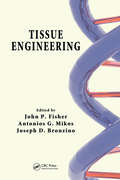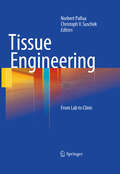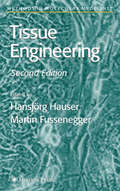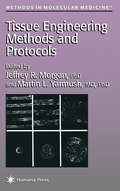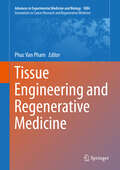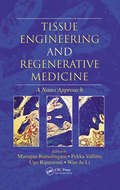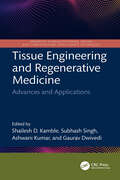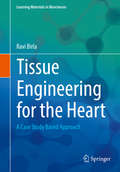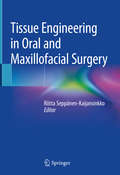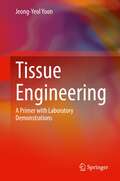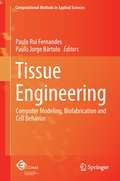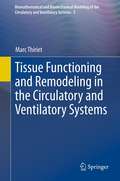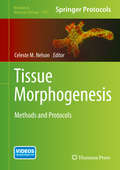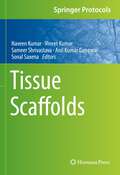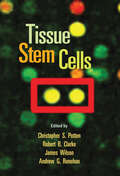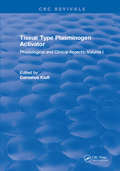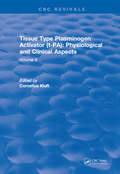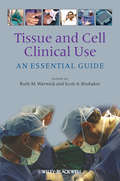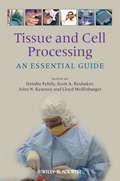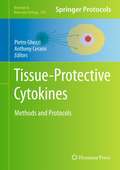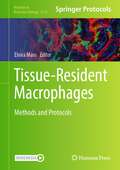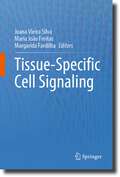- Table View
- List View
Tissue Engineering
by Joseph D. Bronzino John P. Fisher Antonios G. MikosIncreasingly viewed as the future of medicine, the field of tissue engineering is still in its infancy. As evidenced in both the scientific and popular press, there exists considerable excitement surrounding the strategy of regenerative medicine. To achieve its highest potential, a series of technological advances must be made. Putting the numerous
Tissue Engineering
by Norbert Pallua Christoph V. SuschekTissue engineering is a multidisciplinary field incorporating the principles of biology, chemistry, engineering, and medicine to create biological substitutes of native tissues for scientific research or clinical use. Specific applications of this technology include studies of tissue development and function, investigating drug response, and tissue repair and replacement. This area is rapidly becoming one of the most promising treatment options for patients suffering from tissue failure. This abundantly illustrated and well-structured guide serves as a reference for all clinicians and researchers dealing with tissue engineering issues in their daily practice.
Tissue Engineering
by Martin M. Fussenegger Hansjörg HauserThis book provides a comprehensive volume that integrates a wide spectrum of methods required to implement current and future progress in tissue engineering. Leading experts in various disciplines provide examples of recent advances in tissue engineering-related methodologies. Authors present authoritative discussions on topics. The book supplies an understanding of diverse technologies and methods used to drive tissue engineering into a clinical reality. The knowledge contained in this volume represents the impressive progress made in the decade when tissue engineering rapidly evolved.
Tissue Engineering
by Jeffrey R. Morgan Martin L. YarmushThe first major collection of cutting-edge methods developed and used by leading researchers in the tissue engineering field. These hands-on experts describe easily reproducible protocols for the production and evaluation of polymers, scaffolds, and composites, as well as methods for the isolation, culture, and analysis of cells, including the combination of cells with a variety of materials or devices. Quantitative methods designed to assess cell performance and cell function that will also illuminate our understanding of cellular processes and the cellular response to the chemical and mechanical environment of a functional organ/tissue are also offered.
Tissue Engineering And Novel Delivery Systems
by Vasif Hasirci Kai-Uwe Lewandrowski Debra J. Trantolo Michael J. Yaszemski Donald L. Wise David E. AltobelliEssential to anyone working in the field, this reference focuses on latest advancements in tissue construction, repair and regeneration focusing on developments in gene and drug therapy, the evolution of tissue-engineered products, and new technologies for the design of functional tissues and organ systems.
Tissue Engineering and Regeneration in Dentistry: Current Strategies
by Alastair J. Sloan Rachel J. WaddingtonThis pioneering book is uniquely dedicated to the science of Tissue Engineering and Regeneration in Dentistry. It presents the growth of knowledge and advancement in this specialist field along with laboratory considerations for the dental researcher. Furthermore it offers detailed coverage of the basic underlying principles and scientific evidence as well as highlighting the practical applications via 'protocol' boxes throughout. A must-have read for researchers and specialist clinicians in tissue engineering, oral biology, dental materials science, periodontology and oral surgery.
Tissue Engineering and Regenerative Medicine (Advances in Experimental Medicine and Biology #1084)
by Phuc Van PhamThis new series, based on a bi-annual conference and its topics, represents a major contribution to the emerging science of cancer research and regenerative medicine. Each volume brings together some of the most pre-eminent scientists working on cancer biology, cancer treatment, cancer diagnosis, cancer prevention and regenerative medicine to share information on currently ongoing work which will help shape future therapies. These volumes are invaluable resources not only for already active researchers or clinicians but also for those entering these fields, plus those in industry. Tissue Engineering and Regenerative Medicine is a proceedings volume which reflects papers presented at the 3rd bi-annual Innovations in Regenerative Medicine and Cancer Research conference; taken with its companion volume Stem Cells: Biology and Engineering it provides a complete overview of the papers from that meeting of international experts.
Tissue Engineering and Regenerative Medicine: A Nano Approach
by Murugan Ramalingam Ugo Ripamonti Pekka Vallittu Wan-Ju LiThrough the integration of strategies from life science, engineering, and clinical medicine, tissue engineering and regenerative medicine hold the promise of new solutions to current health challenges. This rapidly developing field requires continual updates to the state-of-the-art knowledge in all of the aforementioned sciences. Tissue Engineering
Tissue Engineering and Regenerative Medicine: Advances and Applications (Advances in Manufacturing, Design and Computational Intelligence Techniques)
by Ashwani Kumar Subhash Singh Gaurav Dwivedi Shailesh D. KambleThe book emphasizes the technological advancements in tissue engineering related to biomaterials and biomanufacturing techniques. It further discusses important topics such as 3D bioprinting, process parameter optimization, Convolutional Neural Network (CNN) for stem cell imaging, diabetes risk prediction and Parkinson’s disease detection using machine learning, telehealth systems, acute pancreatitis, and data-driven monitoring of chronic diseases.This book: Explores the role of artificial intelligence in designing biomaterials, optimizing fabrication processes, and predicting tissue formation Focuses on technological advancements in tissue engineering related to biomanufacturing techniques, and biomaterials Discusses the denture base acrylic resins, brain tumor detection, CNN for stem cell imaging and machine learning for diabetes risk prediction and Parkinson’s disease detection. Covers acute myocardial infarction, post-operative urinary retention, telehealth systems, graph convolutional network, and acute pancreatitis. Explains the role of serum magnesium levels in febrile convulsions and Apache-II Score and Ranson Criteria with Modified CT Severity Index. It is primarily written for senior undergraduates, graduate students, and academic researchers in the fields of manufacturing engineering, biomedical engineering, materials science, biomaterials, mechanical engineering, and production engineering.
Tissue Engineering for the Heart
by Ravi BirlaThis book covers the fundamentals of tissue engineering for the heart, starting with the basics of organ generation, sensors in tissue and organ fabrication, and the current state-of-the-art in stem cell engineering for the heart. With this foundation in place, the remaining chapters focus on specific aspects of the cardiovascular system, starting with heart muscle, then biological pumps, followed by bioartificial ventricles, and finally, bioartificial hearts. Throughout the course of this book, twenty-two in-depth case studies are presented. Each case study has been selected to illustrate specific design schemes for tissue and organ fabrication. This is an ideal book for upper-level undergraduate and graduate students studying tissue engineering and organ regeneration, especially those focused on cardiac regeneration. This book also: Includes twenty-two case studies that illustrate specific design schemes for engineering the heart Provides open-ended discussion questions at the end of each chapter as well as a detailed reference list to encourage further research and reading Covers the basics of organ fabrication as well as sensor technology and genetic engineering as they relate to tissue and organ fabrication
Tissue Engineering in Oral and Maxillofacial Surgery
by Riitta Seppänen-KaijansinkkoThis book provides a thorough, up-to-date description of the scientific basis and concepts of tissue engineering in the oral and maxillofacial region. The opening chapters present an introduction to tissue engineering, describe the roles of biomaterials and stem cells, discuss the use of growth factors, and examine potential adverse reactions. The challenges of soft and hard tissue engineering for oral and maxillofacial reconstruction are then considered in detail. It is explained what has been achieved to date, and potential future perspectives are explored. The importance and the verification of adequate vascularization are discussed, and a further focus is the use of 3D printing, both in the planning and production of scaffolds and in the bioprinting of cells and biomaterials. Information is also included on safety, efficacy, and regulatory aspects. Tissue Engineering in Oral and Maxillofacial Surgery will be of interest to all researchers and practitioners who wish to learn more about the potential of tissue engineering to revolutionize practice in oral and maxillofacial surgery.
Tissue Engineering: A Primer with Laboratory Demonstrations
by Jeong-Yeol YoonTissue Engineering: A Primer with Laboratory Demonstrations concisely covers the fundamental basics of tissue engineering. A series of simple, low-cost, and easy-to-implement laboratory modules are included in each chapter, along with experimental results with actual images and data, and a set of questions and discussion topics for each laboratory exercise. The textbook is appropriate for upper-undergraduate and graduate-level courses in cell and tissue engineering. The inclusion of images and data for all laboratory exercises also makes the book a valuable tool for scientists and engineers to learn the concepts in a hands-on and visual manner and lay a foundation to build their experiments towards their research and commercial development.
Tissue Engineering: Computer Modeling, Biofabrication and Cell Behavior
by Paulo Jorge Bártolo Paulo Rui FernandesThis book describes the state of the art on computational modeling and fabrication in Tissue Engineering. It is inspired by the ECCOMAS thematic conference, the European Committee on Computational Methods in Applied Sciences, on Tissue Engineering, held in Lisbon, Portugal, June 2-4, 2011. Tissue Engineering is a multidisciplinary field involving scientists from different fields. The development of mathematical methods is quite relevant to understand cell biology and human tissues as well to model, design and fabricate optimized and smart scaffolds. Emphasis is put on mathematical and computational modeling for scaffold design and fabrication. This particular area of tissue engineering, whose goal is to obtain substitutes for hard tissues such as bone and cartilage, is growing in importance.
Tissue Engineering: Principles, Protocols, and Practical Exercises (Learning Materials in Biosciences)
by Narine SarvazyanTissue engineering and regenerative medicine is a new, interdisciplinary branch of science that combines knowledge from numerous scientific fields including biology, biochemistry, physics, chemistry, applied engineering, and medicine. It aims to restore damaged parts of the human body by rebuilding them in vitro using individual building blocks of biological tissues such as cells and the extracellular matrix that surrounds them. The authors hope to spark students’ interest in this exciting new field of science as well as give them a basic knowledge of its terminology.This book is based on a hands-on practical course in tissue engineering conducted by the Fulbright US Scholar recipient, Dr. Narine Sarvazyan (George Washington University, Washington USA). It provides an overview of the core topics of the tissue engineering field, including stem cell differentiation, the role of extracellular matrix and attachment proteins, scaffolds, and culturing of engineered tissues. Each chapter is accompanied by hands-on demonstrations and self-check questions. The text is easily readable for students of all backgrounds and the described protocols can be conducted using common lab equipment. This textbook is also useful for developing undergraduate and graduate courses that teach basic methods and approaches in this promising and rapidly developing field.
Tissue Functioning and Remodeling in the Circulatory and Ventilatory Systems
by Marc ThirietThe volumes in this authoritative series present a multidisciplinary approach to modeling and simulation of flows in the cardiovascular and ventilatory systems, especially multiscale modeling and coupled simulations. Volume 5 is devoted to cells, tissues, and organs of the cardiovascular and ventilatory systems with an emphasis on mechanotransduction-based regulation of flow. The blood vessel wall is a living tissue that quickly reacts to loads applied on it by the flowing blood. In any segment of a blood vessel, the endothelial and smooth muscle cells can sense unusual time variations in small-magnitude wall shear stress and large-amplitude wall stretch generated by abnormal hemodynamic stresses. These cells respond with a short-time scale (from seconds to hours) to adapt the vessel caliber. Since such adaptive cell activities can be described using mathematical models, a key objective of this volume is to identify the mesoscopic agents and nanoscopic mediators required to derive adequate mathematical models. The resulting biomathematical models and corresponding simulation software can be incorporated into platforms developed in virtual physiology for improved understanding and training.
Tissue Morphogenesis
by Celeste M. NelsonTissue Morphogenesis: Methods and Protocols highlights major techniques, both experimental and computational, for the study of tissue morphogenesis, divided into several sections, with specific focus on techniques to image, manipulate, model and analyze tissue morphogenesis. Chapters focus on imagining analysis of tissue morphogenesis, culture models of tissue morphogenesis, manipulating cells and tissues in vivo, novel model systems to investigate issue morphogenesis and computational models. Written in the highly successful Methods in Molecular Biology series format, chapters include introductions to their respective topics, lists of the necessary materials and reagents, step-by-step, readily reproducible laboratory protocols and tips on troubleshooting and avoiding known pitfalls. Authoritative and practical, Tissue Morphogenesis: Methods and Protocols serves as a primary resource for both fundamental and practical understanding of the techniques used to uncover the basis of tissue morphogenesis.
Tissue Scaffolds (Springer Protocols Handbooks)
by Vineet Kumar Naveen Kumar Sameer Shrivastava Anil Kumar Gangwar Sonal SaxenaThis volume provides a comprehensive introduction into methods and procedures on the preparation and characterization of animal tissue-derived extracellular matrix scaffolds primarily from bubaline, caprine, porcine, ovine, rabbit, rat and fish source. Chapters guide readers through decellularization protocol unique to the particular animal tissue and animal studies outcomes. Authoritative and cutting-edge, Tissue Scaffolds aims to be a useful and practical guide to new researchers and experts looking to expand their knowledge.
Tissue Stem Cells
by Robert B. Clarke James Wilson Christopher S. Potten Andrew G. RenehanTissue stem cells and their medical applications have become a major focus of research over the past decade. With 16 full-color illustrations, this reference provides a thorough and up-to-date overview of the current and emerging technologies for stem cell research and transplantation. Divided into three sections covering general issues, adult stem
Tissue Type Plasminogen Activity: Volume I
by Cornelius KluftThis book is made possible by the enthusiastic contributions of the authors of the chapters. They have been invited from young and active scientists in the field of t-PA research. I am grateful for their contribution and for the fact that all accepted the specifications of their chapter in order to obtain a structured book. Inevitably, some overlap does exist; on the one hand to enable controversial or unsettled areas to be discussed by the different experts with a different approach and background.It is a particular pleasure and honor that Dr. T. Astrup, as an eye-witness and essential contributor to the history of t-PA discovery and research, gives a unique account of the history of t-PA research in the first chapter of the book.
Tissue Type Plasminogen Activity: Volume II
by Cornelius KluftThis book is made possible by the enthusiastic contributions of the authors of the chapters. They have been invited from young and active scientists in the field of t-PA research. I am grateful for their contribution and for the fact that all accepted the specifications of their chapter in order to obtain a structured book. Inevitably, some overlap does exist; on the one hand to enable controversial or unsettled areas to be discussed by the different experts with a different approach and background.It is a particular pleasure and honor that Dr. T. Astrup, as an eye-witness and essential contributor to the history of t-PA discovery and research, gives a unique account of the history of t-PA research in the first chapter of the book.
Tissue and Cell Clinical Use
by Scott A. Brubaker Ruth M. WarwickThis new book explores clinical information in the tissue transplantation field and acts as a comprehensive learning tool to comply with regulatory requirements. Broad in scope, coverage includes all the traditionally transplanted tissues and moves into more complex areas of tissue grafting and the assisted reproduction fields. This useful text focuses on the potential for disease transmission, ways to improve safety, and the role of the clinician in these safety aspects. The book starts off by describing non-surgical risks of using allografts and moves onto chapters devoted completely to tissue- or cell-specific issues relating to transplantation of the individual types of tissues or cells.Tissue and Cell Clinical Use: An Essential Guide is the final book in a series which covers all aspects of tissue banking, donation, processing, and transplantation. Each book in the series includes lists of learning points and case studies which consist of sample processing protocols, descriptions of where processing went wrong, sample risk assessments, or validation studies. This three book series covers all you need to know about tissue banking.
Tissue and Cell Processing
by Scott A. Brubaker Lloyd Wolfinbarger Jr. Deirdre Fehily John N. KearneyBy presenting the latest technological advances and growing national and international regulation, this new book explores state-of-the-art developments in the challenging field of tissue and cell processing. It provides a guide to easier and safer practice in operational principles of preservation, decontamination, and sterilization. Nearly half of the book is devoted completely to tissue- or cell-specific issues relating to processing. With lists of learning points and case studies which consist of sample processing protocols, descriptions of where processing went wrong, sample risk assessments, or validation studies, the authors help you find specific information fast.
Tissue-Protective Cytokines
by Pietro Ghezzi Anthony CeramiWhile many cytokines are known for their inflammatory action, there is a growing interest in the tissue-protective effects of some cytokines. The prototypic tissue-protective cytokine is EPO. Initially described as neuro-protective, it is beneficial in animal models of ischemic and other types of injury. Scientists had to overcome the notion that EPO had only erythropoietic actions, was only produced by the kidney, and that its receptor was only present in erythroid progenitor cells. The use of in vitro and in vivo disease models was essential to demonstrate the protective effects of EPO. Reproducible models will be needed for the further study of the mechanism of action of EPO and for the identification of other tissue-protective cytokines. In Tissue-Protective Cytokines: Methods and Protocols, expert researchers in the field detail the key models that have been used to characterize the tissue-protective actions of cytokines. Written in the highly successful Methods in Molecular BiologyTM series format, chapters include introductions to their respective topics, lists of the necessary materials and reagents, provide step-by-step laboratory protocols, and key tips on troubleshooting and avoiding known pitfalls. Thorough and intuitive, Tissue Protective Cytokines: Methods and Protocols aids scientists in continuing to study tissue-protection that will be a new field of interest of cytokine biology, both in discovering novel actions of known cytokines and in developing new drugs.
Tissue-Resident Macrophages: Methods and Protocols (Methods in Molecular Biology #2713)
by Elvira MassThis detailed book delves into the diverse techniques and applications to target, isolate, image, phenotype, and analyze tissue-resident and monocyte-derived macrophages. The contents aim to describe the current knowledge about macrophage development and function which forces the scientific field to move beyond the previously described M1/M2 macrophage paradigm to be able to dissect macrophage functions within their specific niches during health and disease. Written for the highly successful Methods in Molecular Biology series, chapters include introductions to their respective topics, lists of the necessary materials and reagents, step-by-step and readily reproducible laboratory protocols, and tips on troubleshooting and avoiding known pitfalls. Thorough and practical, Tissue-Resident Macrophages: Methods and Protocols provides scientists entering the macrophage field with information and tools that allow them to dive into the state-of-the-art methodology used in this vital field.
Tissue-Specific Cell Signaling
by Joana Vieira Silva Maria João Freitas Margarida FardilhaSignal transduction comprises the intracellular biochemical signals which induce the appropriate cell response to an external stimulus. The players in signal transduction are diverse, from small molecules as first messengers, to proteins, receptors, transcription factors, among many others. The different signaling pathways and the crosstalk between them originates the unique signaling profile of every cell type in the human body. The cell signaling specificity depends on several aspects including protein composition, subcellular localization and complexes and gene promoters.This textbook provides a comprehensive overview of the specific signaling pathways on a variety of human tissues. This information can be of great value for health science researchers, professionals and students to understand key pathways for tissue-specific functions in the plethora of signals, signals receptors, transducers and effectors.Chapter 3 and 15 are available open access under a Creative Commons Attribution 4.0 International License via link.springer.com.
